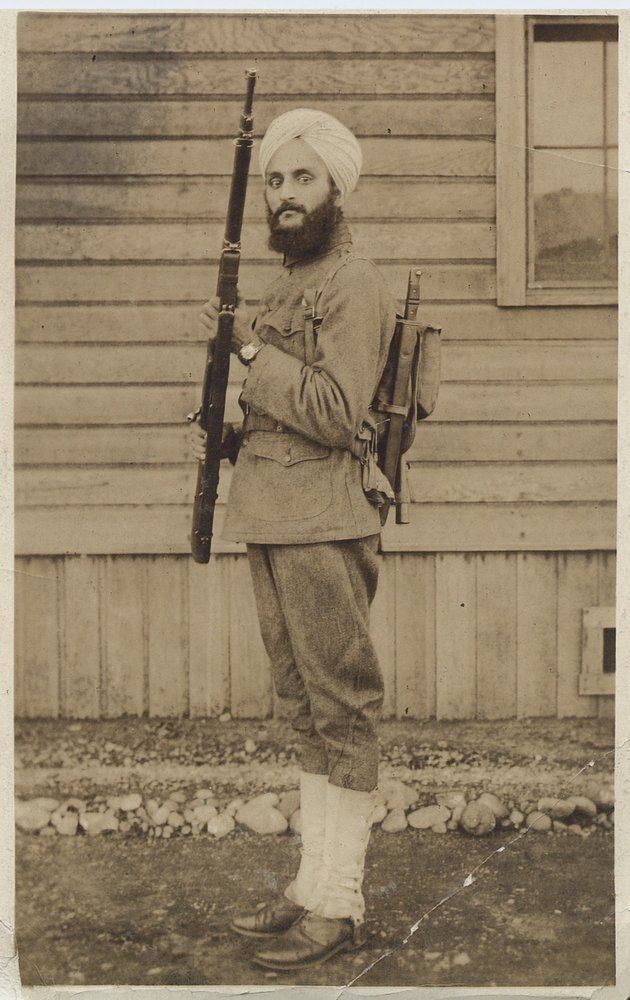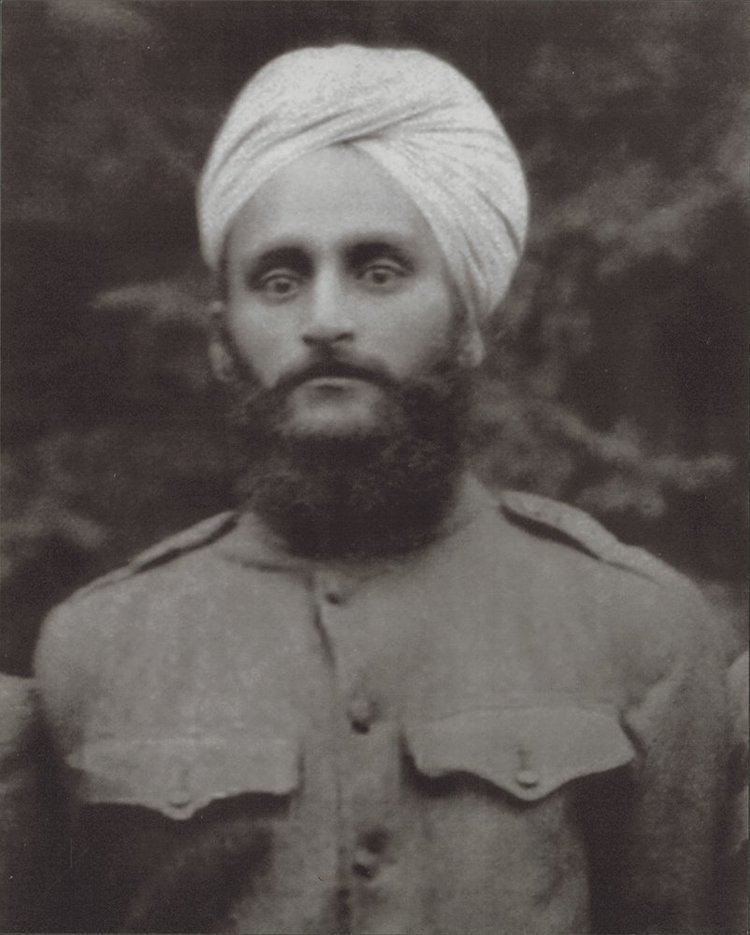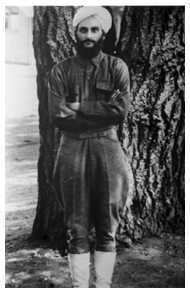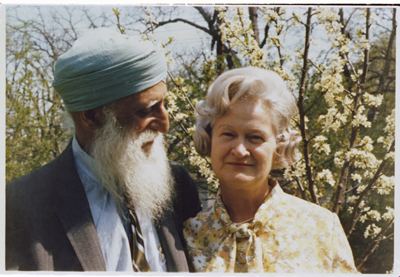Nationality Indian, American Occupation Writer, lecturer | Name Bhagat Thind Role Writer | |
 | ||
Known for Landmark court case denying him naturalized citizenship of the United States, First Turban wearing Singh in US Army Died September 15, 1967, Los Angeles, California, United States Books The Radiant Road To, Wisdom and the Wheel, Divine Wisdom, House Of Happiness, Winners & Whiners in This Whirl | ||
Dr bhagat singh thind early american pioneer
Bhagat Singh Thind (October 3, 1892 – September 15, 1967) was an Indian-American Sikh writer, scientist, and lecturer on spirituality who was involved in an important legal battle over the rights of Indians to obtain U.S. citizenship.
Contents
- Dr bhagat singh thind early american pioneer
- 1923 u s vs bhagat singh thind
- Background
- Becomes US citizen for the second time
- Case sent to higher court
- Thinds citizenship revoked again
- Third attempt
- Thinds contributions
- Death
- Writings
- Posthumously released
- References

Thind had enlisted in the U.S. Army a few months before the end of World War I. After the war he sought the right to become a naturalized citizen, following a legal ruling that Caucasians had access to such rights. In 1923, a crucial Supreme Court case United States v. Bhagat Singh Thind was decided in favor of the United States, retroactively denying all Indian-Americans born abroad citizenship for not being a white person "in accordance with the understanding of the common man."

However, Thind remained in the U.S., completed his PhD, and delivered lectures in metaphysics. Basing his lessons on Sikh religious philosophy, he added to his teaching with references to the scriptures of several religions and the works of Ralph Waldo Emerson, Walt Whitman, and Henry David Thoreau. He campaigned actively for the independence of India from the British Empire. Then, in 1936, Thind applied for and received U.S. citizenship through the state of New York.

1923 u s vs bhagat singh thind
Background

Born on October 3, 1892, in the village of Taragarh Talawa of Amritsar district in the state of Punjab, India which now officially called Taragarh listed as number 68 in this record. He belonged to Thind clan of Kamboj sikh. Present day Thind family of India standing at Village Taragarh/Talawan in District Amritsar, where Dr. Thind was born as shown in website by his son. Bhagat Singh Thind came to the U.S. in 1913 to pursue higher education in an American university. However, on July 22, 1918, he was recruited by the US Army to fight in World War I. A few months later, on November 8, 1918, Bhagat Singh, was promoted to the rank of an Acting Sergeant. He received an honorable discharge on December 16, 1918, with his character designated as "excellent".
U.S. citizenship conferred many rights and privileges but only "free white men" and "persons of African nativity or persons of African descent" could naturalize. In the United States, many anthropologists used Caucasian as a general term for "white". Indian nationals of the high caste, especially from the Indian states of Punjab, Kashmir and various other parts of the Indian subcontinent are also categorised as 'Caucasians' by anthropologists. Thus, several Indians were granted U.S. citizenship in different states. Thind also applied for citizenship from the state of Washington in July 1918.
Thind's citizenship was rescinded four days after it was granted. Eleven months later, he received his citizenship for the second time. However, the Immigration and Naturalization Service appealed to the Ninth Circuit Court of Appeals which sent Thind's case to the Supreme Court for ruling. Thind fought his case in the Supreme Court but the court revoked his citizenship. Indians in the United States and Canada were commonly called "Hindoos" ("Hindus") irrespective of their faith. Thind's nationality was also referred to as "Hindoo" or "Hindu" in all legal documents and the media although he was a Sikh by faith.
Becomes U.S citizen for the second time
He received his citizenship certificate on December 9, 1918, wearing military uniform as he was still serving in the U.S. army. However, the Immigration and Naturalization Service did not agree with the district court granting the citizenship. Thind's citizenship was revoked in four days, on December 13, 1918, on the grounds that he was not a "free white man".
Thind applied for citizenship again from the neighboring state, Oregon, on May 6, 1919. The same Immigration and Naturalization Service official who got Thind’s citizenship revoked first time, tried to convince the judge to refuse citizenship to Thind. He even brought up the issue of Thind's involvement in the Gadar Party, members of which campaigned actively for the independence of India from the British Empire. Judge Wolverton, believing Thind, observed that "He (Thind) stoutly denies that he was in any way connected with the alleged propaganda of the Gadar Press to violate the neutrality laws of this country, or that he was in sympathy with such a course. He frankly admits, nevertheless, that he is an advocate of the principle of India for the Indians, and would like to see India rid of British rule, but not that he favors an armed revolution for the accomplishment of this purpose." The judge took all arguments and Thind’s military record into consideration and declined to agree with the INS. Thus, Thind received US citizenship for the second time on November 18, 1920.
Case sent to higher court
The Immigration and Naturalization Service appealed against the judge’s decision to the next higher court, the Ninth Circuit Court of Appeals, which sent the case to the U.S. Supreme Court for ruling on the following two questions:
- "Is a high caste Hindu of full Indian blood, born at Amritsar, Punjab, India, a white person within the meaning of section 2169, Revised Statutes?"
- "Does the act of February 5, 1917 (39 Stat. L. 875, section 3) disqualify from naturalization as citizens those Hindus, now barred by that act, who had lawfully entered the United States prior to the passage of said act?"
Section 2169, Revised Statutes, provides that the provisions of the Naturalization Act "shall apply to aliens, being free white persons, and to aliens of African nativity and to persons of African descent."
In preparing briefs for the Ninth Circuit Court, Thind's attorney argued that the Immigration Act of 1917 barred new immigrants from India but did not deny citizenship to Indians who, like Thind, were legally admitted before the passage of the new law. The purpose of the Immigration Act was "prospective, and not retroactive."
Thind's citizenship revoked again
Justice George Sutherland of the United States Supreme Court delivered the unanimous opinion of the court on February 19, 1923, in which he argued that since the "common man's" definition of "white" did not correspond to "Caucasian", which Indians were, they could not be naturalized. Thus the Judge, giving his verdict, said, "a negative answer must be given to the first question, which disposes of the case and renders an answer to the second question unnecessary, and it will be so certified."
Thind's citizenship was revoked and the INS issued a certificate in 1926 canceling his citizenship for a second time. The Immigration and Naturalization Bureau also initiated proceedings to rescind United States citizenship granted to Indian-Americans. Between 1923 and 1926, the citizenship of fifty Indians was revoked. The Barred Zone Act of 1917 had already outlawed immigration of Indians.
Third attempt
Thind received his U.S. citizenship through the state of New York in 1936, taking the oath for the third time to become an American citizen.
Thind had come to the U.S. for higher education and to "fulfill his destiny as a spiritual teacher." Long before his arrival in the US or of any other religious teacher or yogi from India, American intellectuals had shown keen interest in Indian religious philosophy. Hindu sacred books translated by the English missionaries had made their way to America and were the “favorite text” of many members of the Transcendentalists' society which was started by some American thinkers and intellectuals who were dissatisfied with the Unitarian Church. The society flourished during the period of 1836–1860 in the Boston area and had some prominent and influential members including author and philosopher Ralph Waldo Emerson (1803–1882), poet Walt Whitman (1819–1892), and writer Henry David Thoreau (1817–62).
Emerson had read Hindu religious and philosophy books including the Bhagavad Gita, and his writings reflected the influence of Indian philosophy. In 1836, Emerson expressed "mystical unity of nature" in his essay, "Nature." In 1868, Walt Whitman wrote the poem "Passage to India." Henry David Thoreau had considerable acquaintance with Indian philosophical works. He wrote an essay on "Resistance to Civil Government, or Civil Disobedience" in 1849 advocating non-violent resistance against unethical government laws. Many years later, in 1906, Mohandas Karamchand Gandhi adopted a similar methodology: satyagraha, or non-violent protest, to defy the law to gain Indian rights in South Africa. Gandhi quoted Thoreau many times in his newspaper, Indian Opinion.
Thind's contributions
Major Contributions of Dr Bhagat Singh Thind :
Thind, during his early life, was influenced by the spiritual teachings of his father whose "living example left an indelible blueprint in him." During his formative years in India, he read the literary writings of American authors Emerson, Whitman, and Thoreau and they too had deeply impressed him. After graduating from Khalsa College, he left for Manila, where he stayed for a year. He resumed his journey and reached Seattle, Washington, on July 4, 1913.
Thind had gained some understanding of the American mind by interacting with students and teachers at the university and with common people by working in lumber mills of Oregon and Washington during summer vacations to support himself while at UC Berkeley. Thus, his teaching included the philosophy of many religions and in particular that contained in Sikh scriptures. During his lectures, discourses and classes to Christian audience, he frequently quoted the Vedas, Guru Nanak, Kabir, etc. He also made references to the works of Ralph Waldo Emerson, Walt Whitman, and Henry David Thoreau to which his American audience could easily relate to. He gave a new "vista of awareness" to his students throughout the United States and was able to initiate "thousands of disciples" into his expanded view of reality – "the Inner Life, and the discovery of the power of the Holy Nãm."
Thind, who had earned a Ph.D, became a writer and was respected as a spiritual guide. He published many pamphlets and books. The list of his books includes Radiant Road to Reality, Science of Union with God, The Pearl of Greatest Price, House of Happiness, Jesus, The Christ: In the Light of Spiritual Science (Vol. I, II, III), The Enlightened Life, Tested Universal Science of Individual Meditation in Sikh Religion, Divine Wisdom in three volumes.
Death
Thind was working on some books when he died on September 15, 1967. He was outlived by his wife, Vivian, who he had married in March 1940 and his daughter Tara and his son David. His son created a website to propagate the philosophy for which his father spent his entire life in the US. He also posthumously published two of his father's books: Troubled Mind in a Torturing World and their Conquest and Winners and Whiners in this Whirling World.
